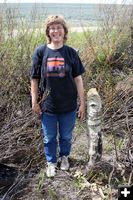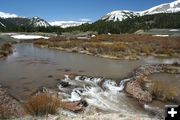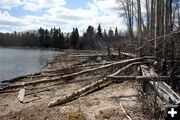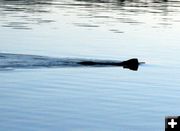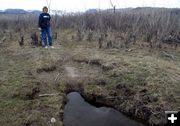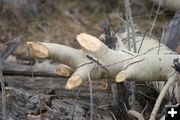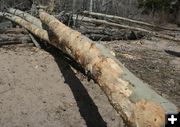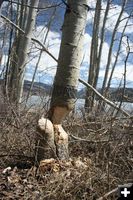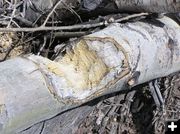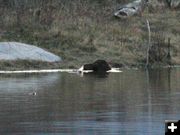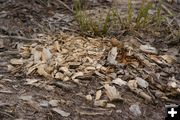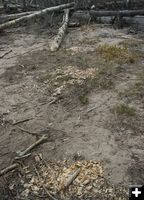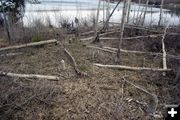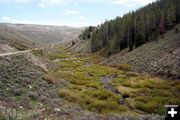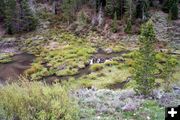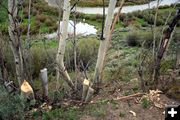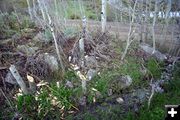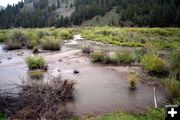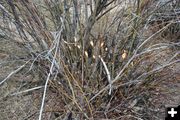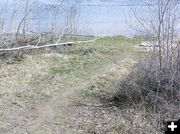
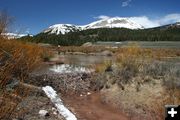
Typical Beaver Pond
A small beaver pond on South Cottonwood Creek in the Wyoming Range, with Triple Peak in the background. The beaver lodge can be seen on the opposite bank.
|


Morning Beaver
Beaver almost always work at night, so are rarely seen. This beaver was seen just after sunrise at New Fork Lake this spring, before it retired to the lodge for the day.
|

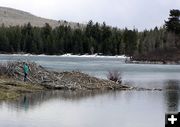
Renovated Beaver Lodge
This large beaver lodge on New Fork Lake has an old section, characterized by more mud, and a new section primarily of logs. The new section is over 5 feet tall. Note the person standing in front of the lodge.
|

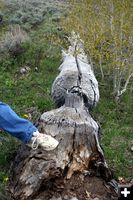
Large Aspen
This aspen tree on Stepp Creek, a tributary of LaBarge Creek, was felled by a beaver many years ago. The trunk measures 2 feet in diameter. Beaver have been known to bring down trees as large as 3.5 feet in diameter.
|
|
Beaver Country
by Clint Gilchrist
May 29, 2006
From 1824 to 1840, the Green River Valley in western Wyoming was the geographic and operational center of the Rocky Mountain Fur Trade. It was the earliest "economic boom" industry in our valley, creating fortunes for many, just as oil and gas is doing here now.
The underfur of the beaver makes the best quality felt. For several hundred years, beaver were trapped throughout the world. During that time, beaver were trapped out of most of the world and even North America. By the 1800s, the Rocky Mountains were the last untapped source of beaver, a gold-mine in its own way.
In 1824, Jed Smith, along with ten other men, came over South Pass and found a "Mother Load" of beaver in the tributaries of the Green River of western Wyoming. This started the Rocky Mountain Fur Trade and created the now-mythical Rendezvous and the Mountain Man.
The Green River Valley was likely trapped heavily in the late 1820s, leaving few beaver to be found in the 1830s. However, because of its central location, the Green River Valley became the preferred location of the summer Rendezvous, the gathering of the trappers, fur traders, Native Americans and trade good suppliers. Half of the 16 rendezvous were held in the Green River Valley, and 6 of the last 8 were held on Horse Creek near Daniel. By 1840, silk hats had become the fashion and beaver trapping was no longer profitable on a large scale, bringing an end to the booming Rocky Mountain fur trade era.
One hundred and sixty six years later, the Upper Green River Valley is still beaver country. Beaver are certainly not as numerous today, but signs of their presence can be found on almost any stream or lake in the area. Unless you stop and look close, it is easy to miss the details of the work of nature’s engineer. Over the past month, we have visited several beaver sites to observe their handiwork in areas not far from Pinedale. None were hard to find, all accessible by roads. By being observant, it is not hard to recognize their activity, and it is another fun thing to do while out exploring this beautiful country.
The beaver is a rodent, cousin to the rat, but well adapted to the water. They are very clumsy on ground. They eat any water vegetation when available, but their preferred food is willow or poplar tree bark and leaves. Their favorite is aspen tree bark and will often go to great lengths to get it.
Beaver habitat is any body of water deep enough to swim in and not freeze solid in the winter. There must also be willow or poplar trees within a few hundred yards, preferable on the banks.
They build their homes, or "lodges", of segments of logs and branches packed with mud. They build an underwater entrance to allow them to enter and leave their lodge safe from natural predators such as bear, wolf and cougars.
In small mountain streams with abundant food, but not large enough to swim, beaver will build dams of sticks and mud to back up the stream flow to create ponds which provide their own habitat and protection.
On large streams and lakes they do not need to build dams and only build lodges on the bank. A beaver dam was found on Coal Creek in the Wyoming Range in the 1950s which was 18-feet tall and created a pond with a perimeter of one mile.
Beavers enlarge their dams when silt starts to fill up the pond or to expand the shoreline as food near the pond is consumed and they need to travel further to obtain it.
Beaver are prolific builders. Ten beaver released on Little Cottonwood Creek in 1949 create 55 dams within 1 year. Although fish, birds and other wildlife thrive in beaver ponds, theese animals are irrelevant to the beaver. Also, beaver do not eat fish as many believe.
A typical adult beaver weighs 40-60 lbs, is 2.5 to 3 feet long, and has a foot-long tail. Beaver have been recorded to weigh as much as 110 pounds. They mate for life and generally do not build a home until they find a mate. They typically have one litter a year with an average of four young, or "kits", which will stay with their parents until they are two years old. At that time, they are kicked out by their parents and must venture out on their own to find a mate and a new home. Beavers have been found roaming as much as 160 miles looking for a mate and a new home.
Beaver typically work almost exclusively at night, so are rarely seen. The best oportunity to see a beaver in day light is in the months of April and May when two-year olds, widowed males, or even families are out looking for a new home.
Beaver will generally avoid humans and are not dangerous. However, if you venture too near their work grounds or lodge during the night, one of the adults will generally swim over and check out the intruder by swimming back and forth sniffing the air and listening. If they determine there is a threat, they raise their tail and slap it on the water as a warning. This sounds a lot like a gun shot and is quite startling and very effective if you are near. Beaver do not have very good far vision, but can hear and smell much better then humans.
Photos by Clint Gilchrist and Dawn Ballou, Pinedale Online!
|




